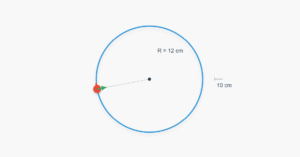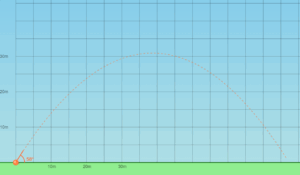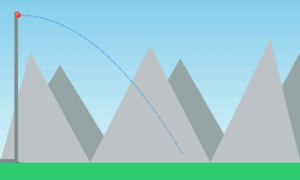3D Particle Motion with Position & Velocity Controls
Initial Position
Initial Velocity
Example
Question:
The position of a particle is given by
\[
\vec{r} = 3.0\,t\,\hat{\imath} + 2.0\,t^2\,\hat{\jmath} + 5.0\,\hat{k}
\]
where \(t\) is in seconds and the coefficients are such that all terms are in metres.
(a) Find \(\vec{v}(t)\) and \(\vec{a}(t)\) of the particle.
(b) Find the magnitude and direction of \(\vec{v}(t)\) at \(t = 1.0\,\mathrm{s}\).
Solution:
The velocity is \[ \vec{v}(t) = \frac{d\vec{r}}{dt} = \frac{d}{dt}\left(3.0\,t\,\hat{\imath} + 2.0\,t^2\,\hat{\jmath} + 5.0\,\hat{k}\right) = 3.0\,\hat{\imath} + 4.0\,t\,\hat{\jmath} \] The acceleration is \[ \vec{a}(t) = \frac{d\vec{v}}{dt} = 4.0\,\hat{\jmath} \] At \(t = 1.0\,\mathrm{s}\): \[ \vec{v}(1.0) = 3.0\,\hat{\imath} + 4.0\,\hat{\jmath} \] Its magnitude is \[ |\vec{v}| = \sqrt{3^2 + 4^2} = 5.0\,\mathrm{m\,s^{-1}} \] and the direction is \[ \theta = \tan^{-1}\left(\frac{v_y}{v_x}\right) = \tan^{-1}\left(\frac{4}{3}\right) \approx 53^\circ \] with respect to the x-axis.
Physics Explanation
This simulation demonstrates uniform linear motion in 3D space. The particle's position at any time t is calculated by:
r(t) = r₀ + v·t
Key Concepts:
- Position (r): The particle's location in 3D space (x,y,z)
- Velocity (v): The rate of change of position (constant in this simulation)
- Uniform Motion: When velocity is constant, position changes linearly with time
- Distance Traveled: Calculated as d = |v|·t (magnitude of velocity multiplied by time)
Interactivity:
- Set initial position and velocity using the sliders
- Start/pause/reset the motion
- Toggle visibility of velocity vector and motion trail
- Drag to rotate the 3D view
- Scroll to zoom in/out



